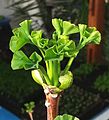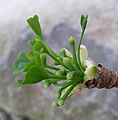Ginkgo biloba
| Ginkgo biloba | |
|---|---|
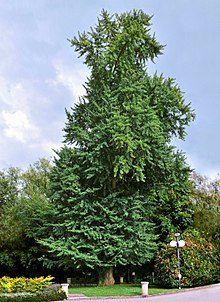
| |
| Scientific classification | |
| Kingdom: | Plantae |
| Clade: | Tracheophytes |
| Clade: | Gymnospermae |
| Division: | Ginkgophyta |
| Class: | Ginkgoopsida |
| Order: | Ginkgoales |
| Family: | Ginkgoaceae |
| Genus: | Ginkgo |
| Species: | G. biloba
|
| Binomial name | |
| Ginkgo biloba | |
| Synonyms[4] | |
| |
Ginkgo biloba,commonly known asginkgoorgingko(/ˈɡɪŋkoʊ,ˈɡɪŋkɡoʊ/GINK-oh, -goh),[5][6]also known as themaidenhair tree,[7]is a species ofgymnospermtree native toEast Asia.It is the last living species in the orderGinkgoales,which first appeared over 290 million years ago, and fossils very similar to the living species, belonging to the genusGinkgo,extend back to theMiddle Jurassicepochapproximately 170 million years ago.[2]The tree was cultivated early inhuman historyand remains commonly planted, and is widely regarded as aliving fossil.
Ginkgo leafextractis commonly used as adietary supplement,but there is insufficientclinical evidencethat it supports human health or is effective against any disease.[8][9]
Etymology
[edit]The genus name is regarded as a misspelling of theJapanese pronunciationgin kyō([ɡiŋkʲoː]) for thekanjiNgân hạnhmeaning "silverapricot",[10]which is found inChinese herbologyliterature such asNhật dụng bổn thảo(Daily UseMateria Medica) (1329) andCompendium of Materia MedicaBổn thảo cương mụcpublished in 1578.[11]
Despite its spelling, which is due to a complicated etymology including a transcription error, "ginkgo" is usually pronounced/ˈɡɪŋkoʊ/,which has given rise to the common alternative spelling "gingko". Thespelling pronunciation/ˈɡɪŋkɡoʊ/is also documented in some dictionaries.[12][13]
Engelbert Kaempferfirst introduced the spellingginkgoin his bookAmoenitatum Exoticarumof 1712.[14]It is considered that he may have misspelled "Ginkjo" or "Ginkio" (both consistent with his treatment of Japanesekyōin the same work) as "Ginkgo". This misspelling was included byCarl Linnaeusin his bookMantissa plantarum II[15]and has become the name of the tree's genus.[16][12]The specific epithetbilobais New Latin for "two-lobed".
Description
[edit]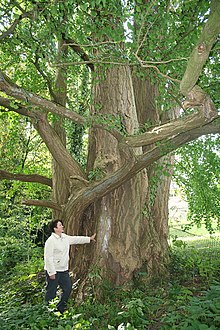
Ginkgos are large trees, normally reaching a height of 20–35 m (66–115 ft),[17]with some specimens in China being over 50 m (165 ft). The tree has an angularcrownand long, somewhat erratic branches, and is usually deep-rooted and resistant to wind and snow damage. Young trees are often tall and slender, and sparsely branched; the crown becomes broader as the tree ages. A combination of resistance to disease, insect-resistant wood, and the ability to formaerial rootsand sprouts makes ginkgos durable, with some specimens claimed to be more than 2,500 years old.[18]
Leaves
[edit]

Theleavesare unique among seed plants, being fan-shaped with veins radiating out into the leaf blade, sometimes bifurcating (splitting), but neveranastomosingto form a network.[19]Two veins enter the leaf blade at the base and fork repeatedly in two; this is known asdichotomous venation.The leaves are usually 5–10 cm (2–4 in), but sometimes up to 15 cm (6 in) long. The old common name,maidenhair tree,derives from the leaves resemblingpinnaeof the maidenhair fern,Adiantum capillus-veneris.Ginkgos are prized for their autumn foliage, which is a deepsaffron yellow.[20]
Leaves of long shoots are usually notched or lobed, but only from the outer surface, between the veins. They are borne both on the more rapidly growing branch tips, where they are alternate and spaced out, and also on the short, stubby spur shoots, where they are clustered at the tips. Leaves are green both on the top and bottom[21]and have stomata on both sides.[22]During autumn, the leaves turn a bright yellow and then fall, sometimes within a short space of time (one to fifteen days).[23]
Branches
[edit]Ginkgo branches grow in length by growth of shoots with regularly spaced leaves, as seen on most trees. From theaxilsof these leaves, "spur shoots" (also known as short shoots) develop on second-year growth. Short shoots have shortinternodes(they may grow only one to two centimeters in several years) and their leaves are usually unlobed. They are short and knobby, and are arranged regularly on the branches except on first-year growth. Because of the short internodes, leaves appear to be clustered at the tips of short shoots, and reproductive structures are formed only on them (see pictures below – seeds and leaves are visible on short shoots). In ginkgos, as in other plants that possess them, short shoots allow the formation of new leaves in the older parts of the crown. After a number of years, a short shoot may change into a long (ordinary) shoot, or vice versa.[24]
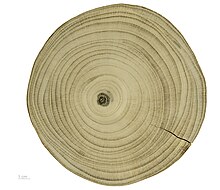
Ginkgo prefers full sun and grows best in environments that are well-watered and well-drained. The species shows a preference for disturbed sites; in the "semiwild" stands atTianmu Mountains,many specimens are found along stream banks, rocky slopes, and cliff edges. Accordingly, ginkgo retains a prodigious capacity for vegetative growth. It is capable of sprouting from embedded buds near the base of the trunk (lignotubers,or basal chichi) in response to disturbances, such as soil erosion. Old specimens are also capable of producing aerial roots on the undersides of large branches in response to disturbances such as crown damage; these roots can lead to successful clonal reproduction upon contacting the soil. These strategies are evidently important in the persistence of ginkgo; in a survey of the "semiwild" stands remaining inTianmushan,40% of the specimens surveyed were multi-stemmed, and few saplings were present.[25]: 86–87
Reproduction
[edit]Ginkgo bilobaisdioecious,with separatesexes,some trees beingfemaleand others beingmale.[26]Male plants produce smallpollen coneswithsporophylls,each bearing twomicrosporangiaspirally arranged around a central axis.
Female plants do not produce cones. Twoovulesare formed at the end of a stalk, and afterwind pollination,[27]one or both develop intofruit-like structures containing seeds. The fruits are 1.5–2 cm long, with a soft, fleshy, yellow-brown outer layer (thesarcotesta) that is attractive in appearance, but containsbutyric acid[28](also known as butanoic acid) and smells foul likerancidbutterorvomit[29]when fallen. Beneath the sarcotesta is the hardsclerotesta(the "shell" of the seed) and a paperyendotesta,with thenucellussurrounding the femalegametophyteat the center.[30]
The fertilization of ginkgo seeds occurs viamotilesperm, as in cycads, ferns, mosses, and algae. The sperm are large (about 70–90 micrometres)[31]and are similar to the sperm of cycads, which are slightly larger.Ginkgosperm were first discovered by the Japanese botanistSakugoro Hirasein 1896.[32]The sperm have a complex multi-layered structure, which is a continuous belt of basal bodies that form the base of several thousand flagella which have a cilia-like motion. The flagella/cilia apparatus pulls the body of the sperm forwards. The sperm have only a tiny distance to travel to the archegonia, of which there are usually two or three. Two sperm are produced, one of which successfully fertilizes the ovule. Fertilization of ginkgo seeds occurs just before or after they fall in early autumn.[19][30]Embryos may develop in the seeds before or after they drop from the tree.[33]
Genome
[edit]Chinese scientists published a draftgenomeofGinkgo bilobain 2016.[34]The tree has a large genome of 10.6 billionDNAnucleobase"letters" (the human genome has three billion) and about 41,840 predictedgenes[35]which enable a considerable number of antibacterial and chemical defense mechanisms.[34]76.58% of the assembled sequence turned out to be repetitive sequences.[36]
In 2020, a study in China ofginkgotrees up to 667 years old showed little effects of aging, finding that the trees continued to grow with age and displayed no genetic evidence ofsenescence,and continued to makephytochemicalsindefinitely.[37]
Phytochemicals
[edit]Extracts of ginkgo leaves containphenolic acids,proanthocyanidins,flavonoid glycosides,such asmyricetin,kaempferol,isorhamnetin,andquercetin,and theterpenetrilactonesginkgolidesandbilobalides.[9][38][39]The leaves also contain unique ginkgobiflavones,alkylphenols,andpolyprenols.[39]
Taxonomy
[edit]The older Chinese name for this plant is ngân quả, meaning "silver fruit", pronouncedyínguǒin Mandarin orNgan-gwoin Cantonese. The current commonly used names are bạch quả (bái guǒ), meaning "white fruit", andNgân hạnh(yínxìng), meaning "silverapricot".The name ngân hạnh was translated intoJapaneseas イチョウ (ichou) or ぎんなん (ginnan) and intoKoreanas 은행 (eunhaeng).
Carl Linnaeusdescribed the species in 1771, thespecific epithetbilobaderived from theLatinbis,"twice" andloba,"lobed", referring to the shape of the leaves.[40]Two names for the species recognise the botanistRichard Salisbury,a placement by Nelson asPterophyllus salisburiensisand the earlierSalisburia adiantifoliaproposed byJames Edward Smith.The epithet of the latter may have been intended to denote a characteristic resemblingAdiantum,the genus of maidenhair ferns.[41]
The scientific nameGinkgois the result of a spelling error that occurred three centuries ago.Kanjitypically have multiple pronunciations in Japanese, and the characters ngân hạnh used forginnancan also be pronouncedginkyō.Engelbert Kaempfer,the firstWesternerto investigate the species in 1690, wrote down this pronunciation in the notes that he later used for theAmoenitates Exoticae(1712) with the "awkward" spelling "ginkgo".[42]This appears to be a simple error of Kaempfer; taking his spelling of other Japanese words containing the syllable "kyō" into account, a more preciseromanizationfollowing his writing habits would have been "ginkio" or "ginkjo".[16]Linnaeus, who relied on Kaempfer when dealing with Japanese plants, adopted the spelling given in Kaempfer's "Flora Japonica" (Amoenitates Exoticae,p. 811). Kaempfer's drawing can be found in Hori's article.[11]
Classification
[edit]The relationship of ginkgo to other plant groups remains uncertain. It has been placed loosely in the divisionsSpermatophytaandPinophyta,but no consensus has been reached. Since its seeds are not protected by anovarywall, it can morphologically be considered agymnosperm.The apricot-like structures produced by female ginkgo trees are technically notfruits,but are seeds that have a shell consisting of a soft and fleshy section (thesarcotesta), and a hard section (thesclerotesta). The sarcotesta has a strong smell that most people find unpleasant.[43][44][45]
The ginkgo is classified in its owndivision,the Ginkgophyta, comprising the single class Ginkgoopsida, order Ginkgoales, familyGinkgoaceae,genusGinkgoand is the onlyextant specieswithin this group. It is one of the best-known examples of aliving fossil,because Ginkgoales other thanG. bilobaare not known from the fossil record after thePliocene.[46][47]
-
ExtinctGinkgo yimaensis[48]
-
ExtinctGinkgo apodes[48]
-
ExtantGinkgo biloba[48]
Evolution
[edit]
Ginkgo bilobais aliving fossil,with fossils recognisably related to modern ginkgo from the earlyPermian(Cisuralian), with likely oldest record being that ofTrichopitysfrom the earliest Permian (Asselian) of France, over 290 million years old.[49]The closest living relatives of thecladeare thecycads,[25]: 84 which share with the extantG. bilobathe characteristic ofmotilesperm.
Such plants withleavesthat have more than fourveinsper segment have customarily been assigned to the taxonGinkgo,while the taxonBaierais used to classify those with fewer than four veins per segment.Sphenobaierahas been used for plants with a broadly wedge-shaped leaf that lacks a distinct leaf stem.[50][51]
Rise and decline
[edit]
Fossils attributable to the genusGinkgofirst appeared in theMiddle Jurassic.The genusGinkgodiversified and spread throughoutLaurasiaduring theJurassicandEarly Cretaceous.[49]
The Ginkgophyta declined in diversity as the Cretaceous progressed, and by thePaleocene,Ginkgo adiantoideswas the onlyGinkgospecies left in theNorthern Hemisphere,while a markedly different (and poorly documented) form persisted in theSouthern Hemisphere.Along with that of ferns, cycads, and cycadeoids, the species diversity in the genusGinkgodrops through the Cretaceous, at the same time the flowering plants were on the rise; this supports the hypothesis that, over time, flowering plants with better adaptations to disturbance displacedGinkgoand its associates.[25]: 93
At the end of thePliocene,Ginkgofossils disappeared from the fossil record everywhere except in a small area ofcentral China,where the modern species survived.
Limited number of species
[edit]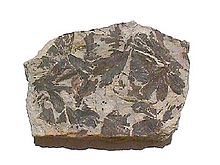
It is doubtful whether the Northern Hemisphere fossil species ofGinkgocan be reliably distinguished. Given the slow pace of evolution and morphological similarity between members of the genus, there may have been only one or two species existing in the Northern Hemisphere through the entirety of theCenozoic:present-dayG. biloba(includingG. adiantoides) andG. gardnerifrom thePaleoceneofScotland.[25]: 85
At least morphologically,G. gardneriand the Southern Hemisphere species are the only known post-Jurassic taxa that can be unequivocally recognised. The remainder may have beenecotypesorsubspecies.The implications would be thatG. bilobahad occurred over an extremely wide range, had remarkable genetic flexibility and, thoughevolvinggenetically, never showed muchspeciation.[52][53]
While it may seem improbable that a single species may exist as a contiguous entity for many millions of years, many of the ginkgo's life-history parameters fit: Extreme longevity; slow reproduction rate; (in Cenozoic and later times) a wide, apparently contiguous, but steadily contracting distribution; and (as far as can be demonstrated from the fossil record) extreme ecological conservatism (restriction to disturbed streamside environments).[25]: 91
Adaptation to a single environment
[edit]Given the slow rate of evolution of the genus,Ginkgopossibly represents a pre-angiospermstrategy for survival in disturbed streamside environments.Ginkgoevolved in an era before flowering plants, whenferns,cycads,andcycadeoidsdominated disturbed streamside environments, forming low, open, shrubby canopies.Ginkgo'slarge seeds and habit of "bolting" – growing to a height of 10 meters before elongating its side branches – may be adaptations to such an environment.
Modern-dayG. bilobagrows best in environments that are well-watered and drained,[25]: 87 and the extremely similar fossilGinkgofavored similar environments: The sediment record at the majority of fossilGinkgolocalities indicates it grew primarily indisturbed environments,such as along streams.[25]Ginkgo,therefore, presents an "ecological paradox" because while it possesses some favorable traits for living in disturbed environments (clonal reproduction) many of its other life-history traits are the opposite of those exhibited by modern plants that thrive in disturbed settings (slow growth, large seed size, late reproductive maturity).[25]: 92
Distribution and habitat
[edit]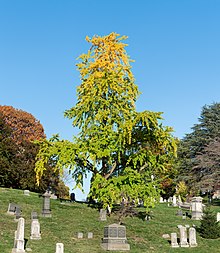
AlthoughGinkgo bilobaand other species of the genus were once widespread throughout the world, its habitat had shrunk by two million years ago.
For centuries, it was thought to be extinct in the wild,[54]but is now a common tree cultivated throughout eastern China, Korea, and Japan. Many municipalities in Korea and Japan use Ginkgos as street trees, and Ginkgo leaves are the emblem of prominent educational institutions such as theUniversity of TokyoandSungkyunkwan Universityin South Korea. Despite their widespread habitat, highgenetic uniformityexists among ginkgo trees, with some Chinese scholars suggesting that ginkgo trees in these areas may have been planted and preserved by Chinese monks over about 1,000 years.[55]A study demonstrates a greater genetic diversity inSouthwestern Chinapopulations, supporting glacial refugia in mountains surrounding the easternTibetan Plateau,where several old-growth candidates for wild populations have been reported.[55][56]Recently, the findings of Ginkgo trees aged 1,500 years inSamcheok-si,Korea (the Neukguri Ginkgo, designated as Korea's natural artifact in 1986),[57]and aged 1,200 inTsurugaoka Hachimangu Shrinein Japan have discredited theories claiming Chinese origins of Ginkgo.[citation needed]Whether native ginkgo populations still exist has not been demonstrated unequivocally, but there is genetic evidence that these Southwestern populations may be wild, as well as evidence that the largest and oldestGinkgo bilobatrees may be older than surrounding human settlements.[55]
Where it occurs in the wild, Ginkgo is found infrequently in deciduous forests and valleys on acidicloess(i.e. fine, silty soil) with good drainage. The soil it inhabits is typically in the pH range of 5.0 to 5.5.[58]
Cultivation
[edit]
Ginkgo has long been cultivated in China. It is common in the southern third of the country.[58]Some planted trees at temples are believed to be over 1,500 years old. The first record of Europeans encountering it is in 1690 inJapanese temple gardens,where the tree was seen by the German botanistEngelbert Kaempfer.Because of its status inBuddhismandConfucianism,the ginkgo has also been widely planted in Korea and in Japan since the 14th century;[59]in both areas, some naturalization has occurred, with ginkgos seeding into natural forests. Ginkgo has been commonly cultivated in North America for over 200 years and in Europe for close to 300, but during that time, it has never become significantlynaturalized.[60]
G. bilobais also commonly manually planted in cities across the United States and Europe. This species is highly tolerant to pollution and serves as a visually appealing, shade-providing tree in many cities and gardens.[61]
Many intentionally planted ginkgos are malecultivarsgrafted onto plants propagated from seed, because the male trees will not produce the malodorous seeds. The popular cultivar 'Autumn Gold' is a clone of a male plant.[citation needed]
The disadvantage of maleGinkgo bilobatrees is that they are highly allergenic. They have an OPALS (Ogren Plant Allergy Scale) rating of 7 (out of 10), whereas female trees, which can produce nopollen,have an OPALS allergy scale rating of 2.[62]
Female cultivars include 'Liberty Splendor', 'Santa Cruz', and 'Golden Girl', the latter so named because of the striking yellow color of its leaves in the fall; all female cultivars release zero pollen.[62]
Many cultivars are listed in the literature in theUK,of which the compact 'Troll' has gained theRoyal Horticultural Society'sAward of Garden Merit.[63][64]
Ginkgos adapt well to the urban environment, tolerating pollution and confined soil spaces.[65]They rarely have disease problems, even in urban conditions, and are attacked by few insects.[66][67]
Ginkgos are popular subjects for growing as miniature landscapes known aspenjingandbonsai;[68]they can be kept artificially small and tended over centuries. The trees are easy to propagate from seed.
Hiroshima
[edit]Extreme examples of the ginkgo's tenacity may be seen inHiroshima,Japan, where six trees growing between1 and 2 kilometres (1⁄2and1+1⁄4miles) from the1945 atom bomb explosionwere among the few livingorganismsin the area to survive the blast. Although almost all other plants (and animals) in the area were killed, the ginkgos, though charred, survived and were soon healthy again, among otherhibakujumoku(trees that survived the blast).[citation needed]
The six trees are still alive: They are marked with signs at Housenbou(Báo chuyên phường)temple (planted in 1850),Shukkei-en(planted about 1740), Jōsei-ji (planted 1900), at the former site of Senda Elementary School near Miyukibashi, at theMyōjōin temple,and anEdo period-cutting atAnraku-jitemple.[69]
1000-year-old ginkgo at Tsurugaoka Hachimangū
[edit]
At theTsurugaoka Hachiman-gū'sshrine in the city ofKamakura,Kanagawa Prefecture,Japan, an ancient ginkgo tree stands beside the stone entry staircase. According to legend, the tree has stood there since the founding of the shrine circa 1063.[70]The tree is nicknamedkakure-ichō(hiding ginkgo), because of anEdo periodlegend in whichshōgunMinamoto no Sanetomowas assassinated in 1219 by his nephew,Kugyō,who had hidden behind the tree to ambush the shōgun.[70]
Modern scholarship has established that ginkgos arrived from China in the 14th century, and a 1990 tree-ring measurement indicated thekakure-ichō'sage to be about 500 years.[11]
On 10 March 2010, the tree blew down in a storm, but the stump has since sprouted vigorously.[70]
1,400-year-old ginkgo tree at Gu Guanyin
[edit]The grounds of the Buddhist temple at Gu Guanyin in theZhongnan Mountainsfeature a ginkgo tree reputed to be 1,400 years old.[71][72]The tree itself is a popular tourist attraction.
Uses
[edit]The wood ofGinkgo bilobais used to make furniture, chessboards, carving, and casks for makingsaké;the wood is fire-resistant and slow to decay.[54]
Culinary
[edit]


The nut-like kernels of the seeds are particularly esteemed in Asia, and are a traditional ingredient inChinese food.Ginkgo nuts are used incongee,and are often served at special occasions such as weddings and theChinese New Year(as part of the vegetarian dish calledBuddha's delight). Japanese cooks add ginkgo seeds (calledginnan) to dishes such aschawanmushi,and cooked seeds are often eaten along with other dishes. Grilled ginkgo nuts with salt are also a popular item atizakayasas a healthy snack with beer and other Japanese food.[73]In Korea, ginkgo nuts are stir-fried and eaten, or are used to garnish foods such assinseonro.[74]
When eaten in large quantities or over a long period, the seeds may cause poisoning byginkgotoxin(4'-O-methylpyridoxine, MPN), as found in a fewcase reports.[75][76]A heat-stable compound not destroyed by cooking, MPN may cause convulsions, which were alleviated by treatment withpyridoxinephosphate(vitamin B6), according to limited studies.[75][76]
Some people are sensitive to the chemicals in thesarcotesta,the outer fleshy coating. These people should handle the seeds with care when preparing the seeds for consumption, wearing disposable gloves. The symptoms are allergic contactdermatitis,[77][78]orblisterssimilar to that caused by contact withpoison ivy.[79]
Medical research
[edit]AlthoughextractsofGinkgo bilobaleaf are often marketed as cognitive enhancers, there is no evidence for effects on memory or attention in healthy people.[8][80]Systematic reviewshave shown there is no evidence for effectiveness of ginkgo in treatinghigh blood pressure,[81]menopause-related cognitive decline,[82]tinnitus,[83][84]post-strokerecovery,[85]oraltitude sickness.[86]
There is weak preliminary evidence for ginkgo affectingdementia[87][88][89]andtardive dyskinesiasymptoms in people withschizophrenia.[90]
Adverse effects
[edit]Side effectsof using ginkgo supplements may include increased risk of bleeding,gastrointestinal discomfort,nausea,vomiting,diarrhea,headaches, dizziness, heartpalpitations,and restlessness.[8][9]Although use ofstandardizedGinkgo bilobaleaf extracts in moderate amounts appears to be safe,[8]excessive use may have undesirable effects, especially in terms ofdrug interactions.[9]The dosing ofanticoagulants,such aswarfarinor antiplatelet medication, may be adversely affected by using ginkgo supplements.[8][9]
According to asystemic review,the effects of ginkgo onpregnantwomen may include increasedbleeding time,and there is inadequate information about safety duringlactation.[9][91]
Ginkgopollenmay produceallergic reactions.[9]Ginkgo bilobaleaves andsarcotestacontain ginkgolic acids[92]– which are highlyallergenic– long-chain alkylphenols, such asbiloboloradipostatin A[93](bilobol is a substance related toanacardic acidfromcashew nutshells andurushiolspresent inpoison ivyand otherToxicodendronspp.)[9][78]Individuals with a history of strong allergic reactions to poison ivy, mangoes, cashews and other alkylphenol-producing plants are more likely to experience an allergic reaction when consuming non-standardized ginkgo-containing preparations.[9]The level of these allergens in standardized pharmaceutical preparations fromGinkgo bilobawas restricted to 5ppmby theCommission Eof the former Federal German Health Authority. Overconsumption of seeds fromGinkgo bilobacan depletevitamin B6.[94][95]
Since 2016,Ginkgo bilobaextract is classified as a possible humancarcinogen(group 2B) by theInternational Agency for Research on Cancer.[96]
Traditional medicine
[edit]Ginkgo has been used intraditional Chinese medicinesince at least the 11th century C.E.[97]Ginkgo seeds, leaves, and nuts have traditionally been used to treat various ailments, such as dementia, asthma, bronchitis, and kidney and bladder disorders. However, there is no conclusive evidence that ginkgo is useful for any of these conditions.[8][9][98]
TheEuropean Medicines AgencyCommittee on Herbal Medicinal Productsconcluded that medicines containing ginkgo leaf can be used for treating mild age-relateddementiaand mildperipheral vascular diseasein adults after serious conditions have been excluded by a physician.[99]
Society and culture
[edit]
The ginkgo leaf is the symbol of theUrasenkeschool ofJapanese tea ceremony.The tree is the official tree of the Japanese capital ofTokyo,and the symbol of Tokyo is a ginkgo leaf. Since 1948, the badge ofTokyo Universityhas been two ginkgo leaves (designed by Shoichi Hoshino), which became the university logo in 2004 with a redesign.[100]The logo ofOsaka Universityhas been a simplified ginkgo leaf since 1991 when designerIkko Tanakacreated it for the university's sixtieth anniversary.[101]
In professionalsumo,wrestlers ranked in the two highest divisions (jūryōandmakuuchi) wear an elaboratetopknotcalledōichōmage(Đại ngân hạnh 髷,lit. 'ginkgo-leaf topknot')because it resembles the leaf of the ginkgo tree.[102]
Ginkgo is an official tree ofSeoulsince 1971, designated by theSeoul Metropolitan Government.[103]
Gallery
[edit]-
Trunk bark
-
Ginkgo pollen-bearing cones
-
Bud in spring
-
Ovules ready for fertilization
-
Female gametophyte, dissected from a seed freshly shed from the tree, containing a well-developed embryo
-
Immature ginkgo ovules and leaves
-
Autumn leaves and fallen seeds
-
A forest of saplings sprout among last year's seeds
-
Ginkgo tree inautumn
-
Seeds on tree
-
Ginkgo biloba leaves
-
Ginkgo in autumn in Florence (Italy)
-
Several golden ginkgos in Hebei, China
See also
[edit]- André Michaux,introduced the ginkgo toNorth America[104]
- Bartheletia paradoxa,a unique species of fungus that grows exclusively onGinkgoleaves
- Ginkgo Petrified Forest State Parkin centralWashington,United States
- Herbalism
- List of edible seeds
References
[edit]- ^Mustoe, G.E. (2002). "Eocene Ginkgo leaf fossils from the Pacific Northwest".Canadian Journal of Botany.80(10): 1078–1087.doi:10.1139/b02-097.
- ^abSun, W. (1998)."Ginkgo biloba".IUCN Red List of Threatened Species.1998:e.T32353A9700472.doi:10.2305/IUCN.UK.1998.RLTS.T32353A9700472.en.Retrieved19 November2021.
- ^"NatureServe Explorer 2.0".explorer.natureserve.org.Retrieved31 March2022.
- ^"Ginkgo biloba",World Checklist of Selected Plant Families,Royal Botanic Gardens, Kew,retrieved1 July2024
- ^"Ginkgo: Definition & Meaning".www.merriam-webster.com.Retrieved2 July2021.
- ^"ginkgo".dictionary.cambridge.org.Retrieved2 July2021.
- ^USDA, NRCS(n.d.)."Ginkgo biloba".The PLANTS Database (plants.usda.gov).Greensboro, North Carolina: National Plant Data Team.Retrieved19 January2016.
- ^abcdef"Ginkgo".National Center for Complementary and Integrative Health, US National Institutes of Health. 1 August 2020.Retrieved19 February2021.
- ^abcdefghij"Ginkgo biloba".Drugs.com. 19 December 2023.Retrieved13 April2024.
- ^Coombes, Allen J. (1994),Dictionary of Plant Names,London: Hamlyn Books,ISBN978-0-600-58187-1
- ^abcT. Hori, A historical survey of Ginkgo biloba based on Japanese and Chinese classical literatures, Plant Morphology, 2001, 31, 31–40
- ^ab"ginkgo".LexicoUK English Dictionary.Oxford University Press.Archived fromthe originalon 22 March 2020.
- ^"ginkgo".Merriam-Webster.com Dictionary.Merriam-Webster.
- ^Kaempfer, Engelbert(1712).Amoenitatum exoticarum(in Latin).Lemgoviae:Typis & impensis Henrici Wilhelmi Meyeri, aulae Lippiacae typographi. pp. 811–813.(with illustration)
- ^See page 131 of Car. a LinnéMantissa plantarum:Generum editionis VI. et specierum editionis II, available at[1]
- ^abMichel, Wolfgang (2011) [2005]."On Engelbert Kaempfer's 'Ginkgo'"(PDF).Fukuoka: Kyushu University. pp. 1–5.
- ^Ansari, Abid A.; Gill, Sarvajeet Singh; Abbas, Zahid Khorshid; Naeem, M. (23 December 2016).Plant Biodiversity: Monitoring, Assessment and Conservation.CABI.ISBN978-1-78064-694-7.
- ^"Ginkgo – Ginkgo biloba – The University of Alabama Arboretum | The University of Alabama".arboretum.ua.edu.Retrieved26 February2022.
- ^ab"More on Morphology of the Ginkgoales".www.ucmp.berkeley.edu.Archived fromthe originalon 17 October 2000.Retrieved12 August2006.
- ^Meyer, Jeffrey G. (2004).The Tree Book: A Practical Guide to Selecting and Maintaining the Best Trees for Your Yard and Garden.Simon and Schuster. p. 113.ISBN978-0-7432-4974-4.
- ^"Ginkgo Tree".www.bio.brandeis.edu.Retrieved18 July2016.[permanent dead link]
- ^"Ginkgo Tree".prezi.com.Retrieved18 July2016.
- ^"PlantsMap".Plants Map.Retrieved24 June2022.
- ^Brenner, Eric D.; Katari, Manpreet S.; Stevenson, Dennis W.; Rudd, Stephen A.; Douglas, Andrew W.; Moss, Walter N.; Twigg, Richard W.; Runko, Suzan J.; Stellari, Giulia M.; McCombie, W. R.; Coruzzi, Gloria M. (15 October 2005)."EST analysis in Ginkgo biloba: an assessment of conserved developmental regulators and gymnosperm specific genes".BMC Genomics.6:143.doi:10.1186/1471-2164-6-143.ISSN1471-2164.PMC1285361.PMID16225698.
- ^abcdefghRoyer, Dana L.; Hickey, Leo J.; Wing, Scott L. (2003). "Ecological conservatism in the 'living fossil'Ginkgo".Paleobiology.29(1): 84–104.doi:10.1666/0094-8373(2003)029<0084:ECITLF>2.0.CO;2.ISSN0094-8373.S2CID19865243.
- ^Pendarvis, Murray P.; Crawley, John L. (1 February 2018).Exploring Biology in the Laboratory, 3e.Morton Publishing Company.ISBN978-1-61731-756-9.
- ^Jin, Biao; Jiang, Xiaoxue; Wang, Di; Zhang, Lei; Wan, Yinglang; Wang, Li (September 2012)."The behavior of pollination drop secretion in Ginkgo biloba L."Plant Signaling & Behavior.7(9): 1168–1176.Bibcode:2012PlSiB...7.1168J.doi:10.4161/psb.21122.ISSN1559-2324.PMC3489653.PMID22899081.
- ^Raven, Peter H.; Ray F. Evert; Susan E. Eichhorn (2005).Biology of Plants(7th ed.). New York: W. H. Freeman and Company. pp. 429–430.ISBN978-0-7167-1007-3.
- ^Plotnik, Arthur (2000).The Urban Tree Book: An Uncommon Field Guide for City and Town(1st ed.). New York: Three Rivers Press. p.202.ISBN978-0-8129-3103-7.
- ^ab"Lab IX – Ginkgo, Cordaites, Conifers (2)".ucmp.berkeley.edu.
- ^Vanbeek, A. (2000).Ginkgo Biloba (Medicinal and Aromatic Plants: Industrial Profiles).CRC Press. p. 37.ISBN978-90-5702-488-7.
- ^Ogura, Y. (1967)."History of Discovery of Spermatozoids InGinkgo bilobaandCycas revoluta".Phytomorphology.17:109–114. Archived fromthe originalon 26 September 2015.
- ^Holt, B. F.; Rothwell, G. W. (1997)."Is Ginkgo biloba (Ginkgoaceae) Really an Oviparous Plant?".American Journal of Botany.84(6): 870–872.doi:10.2307/2445823.JSTOR2445823.PMID21708639.
- ^abGuan, Rui; Zhao, Yunpeng; Zhang, He; Fan, Guangyi; Liu, Xin; Zhou, Wenbin; Shi, Chengcheng; Wang, Jiahao; Liu, Weiqing (1 January 2016)."Draft genome of the living fossil Ginkgo biloba".GigaScience.5(1): 49.doi:10.1186/s13742-016-0154-1.ISSN2047-217X.PMC5118899.PMID27871309.
- ^"Ginkgo 'living fossil' genome decoded".BBC News.21 November 2016.Retrieved23 November2016.
- ^Draft genome of the living fossil Ginkgo biloba – GigaScience
- ^Hunt, Katie (14 January 2020)."Some trees can live for more than 1,000 years and scientists may have figured out why".CNN.Retrieved19 January2020.
- ^van Beek TA (2002). "Chemical analysis of Ginkgo biloba leaves and extracts".Journal of Chromatography A.967(1): 21–55.doi:10.1016/S0021-9673(02)00172-3.PMID12219929.
- ^abvan Beek TA, Montoro P (2009). "Chemical analysis and quality control of Ginkgo biloba leaves, extracts, and phytopharmaceuticals".J Chromatogr A.1216(11): 2002–2032.doi:10.1016/j.chroma.2009.01.013.PMID19195661.
- ^Simpson DP (1979).Cassell's Latin Dictionary(5 ed.). London: Cassell Ltd. p. 883.ISBN978-0-304-52257-6.
- ^Chandler, Brian (2000)."Ginkgo Origins".Ginkgo pages.Retrieved22 November2010.
- ^Engelbert Kaempfer (1721).Amoenitates exoticae politico-physico-medicae(in Latin). Lengoviae: Meyer.
- ^Jaikumar, Devika (15 May 2008)."Wake Up and Smell the Ginkgos".Arnold Arboretum.Retrieved13 June2024.
- ^Šamec, Dunja; Karalija, Erna; Dahija, Sabina; Hassan, Sherif T. S. (23 May 2022)."Biflavonoids: Important Contributions to the Health Benefits of Ginkgo (Ginkgo biloba L.)".Plants.11(10): 1381.doi:10.3390/plants11101381.ISSN2223-7747.PMC9143338.PMID35631806.
- ^Duara, Nigel (5 October 2009)."Smell has some cities ripping out ginkgo trees".The Seattle Times.Retrieved13 June2024.
- ^Zhou, Zhiyan; Zheng, Shaolin (2003). "Palaeobiology: The missing link in Ginkgo evolution".Nature.423(6942): 821–822.Bibcode:2003Natur.423..821Z.doi:10.1038/423821a.PMID12815417.S2CID4342303.
- ^Julie Jalalpour; Matt Malkin; Peter Poon; Liz Rehrmann; Jerry Yu (1997)."Ginkgoales: Fossil Record".University of California, Berkeley.Retrieved3 June2008.
- ^abcdApproximate reconstructions by B. M. Begović Bego and Z. Zhou, 2010/2011. Source: B.M. Begović Bego, (2011). Nature's MiracleGinkgo biloba,Book 1, Vols. 1–2, pp. 60–61.
- ^abZhou, Zhi-Yan (March 2009)."An overview of fossil Ginkgoales".Palaeoworld.18(1): 1–22.doi:10.1016/j.palwor.2009.01.001.
- ^Unverfärth, Jan; McLoughlin, Stephen; Möllmann, Magali; Bomfleur, Benjamin (2 October 2022)."Sphenobaiera insecta from the Upper Triassic of South Australia, with a clarification of the genus Sphenobaiera (fossil Ginkgophyta) and its delimitation from similar foliage genera".Botany Letters.169(4): 442–453.Bibcode:2022BotL..169..442U.doi:10.1080/23818107.2022.2076259.ISSN2381-8107.
- ^Wang, Yongdong; Guignard, Gaëtan; Thévenard, Frédéric; Dilcher, David; Barale, Georges; Mosbrugger, Volker; Yang, Xiaoju; Mei, Shengwu (2005)."Cuticular anatomy of Sphenobaiera huangii (Ginkgoales) from the Lower Jurassic of Hubei, China".American Journal of Botany.92(4): 709–721.doi:10.3732/ajb.92.4.709.ISSN0002-9122.PMID21652450.
- ^Zhao, Yun-Peng; Fan, Guangyi; Yin, Ping-Ping; Sun, Shuai; Li, Ning; Hong, Xiaoning; Hu, Gang; Zhang, He; Zhang, Fu-Min; Han, Jing-Dan; Hao, Ya-Jun; Xu, Qiwu; Yang, Xianwei; Xia, Wenjie; Chen, Wenbin (13 September 2019)."Resequencing 545 ginkgo genomes across the world reveals the evolutionary history of the living fossil".Nature Communications.10(1): 4201.Bibcode:2019NatCo..10.4201Z.doi:10.1038/s41467-019-12133-5.ISSN2041-1723.PMC6744486.PMID31519986.
- ^Gong, Wei; Chen, Chuan; Dobes, Christoph; Fu, Cheng-Xin; Koch, Marcus A. (2008)."Phylogeography of a living fossil: pleistocene glaciations forced Ginkgo biloba L. (Ginkgoaceae) into two refuge areas in China with limited subsequent postglacial expansion".Molecular Phylogenetics and Evolution.48(3): 1094–1105.Bibcode:2008MolPE..48.1094G.doi:10.1016/j.ympev.2008.05.003.ISSN1095-9513.PMID18554931.
- ^abUsher, Carol; White, John; Ridsdale, Colin (17 October 2005).Eyewitness Companions: Trees: Identification, Forests, Historic Species, Wood Types.Penguin.ISBN978-0-7566-4865-7.
- ^abcShen, L; Chen, X-Y; Zhang, X; Li, Y-Y; Fu, C-X; Qiu, Y-X (2004)."Genetic variation of Ginkgo biloba L. (Ginkgoaceae) based on cpDNA PCR-RFLPs: inference of glacial refugia".Heredity.94(4): 396–401.doi:10.1038/sj.hdy.6800616.PMID15536482.
- ^Tang, CQ; al, et (2012)."Evidence for the persistence of wild Ginkgo biloba (Ginkgoaceae) populations in the Dalou Mountains, southwestern China".American Journal of Botany.99(8): 1408–1414.doi:10.3732/ajb.1200168.PMID22847538.
- ^"강원특별자치도 기념물 삼척늑구리은행나무 ( tam trắc nột khẩu lí ngân hạnh 나무): 국가문화유산포털 – 문화재청".Heritage Portal: CULTURAL HERITAGE ADMINISTRATION(in Korean).Retrieved14 October2023.
- ^abFu, Liguo; Li, Nan; Mill, Robert R. (1999)."Ginkgo biloba".In Wu, Z. Y.; Raven, P.H.; Hong, D.Y. (eds.).Flora of China.Vol. 4. Beijing: Science Press; St. Louis: Missouri Botanical Garden Press. p. 8.
- ^Roger Cohn (1 May 2013)."The life story of the oldest tree on Earth (interview of Peter Crane)".Yale Environment 360, Yale School of the Environment.Retrieved3 September2021.
- ^Whetstone, R. David (2006)."Ginkgo biloba".Flora of North America.Vol. 2. New York & Oxford: Oxford University Press.
- ^Wang, Lukun; Liu, Jiamin; Liu, Jing; Wei, Haiyan; Fang, Yaqin; Wang, Daju; Chen, Ruidun; Gu, Wei (1 May 2023). "Revealing the long-term trend of the global-scale Ginkgo biloba distribution and the impact of future climate change based on the ensemble modeling".Biodiversity and Conservation.32(6): 2077–2100.Bibcode:2023BiCon..32.2077W.doi:10.1007/s10531-023-02593-z.ISSN1572-9710.S2CID257939546.
- ^abOgren, Thomas Leo (2000).Allergy-Free Gardening.Berkeley, California: Ten Speed Press. p.112.ISBN978-1-58008-166-5.
- ^"RHS Plantfinder –Ginkgo biloba'Troll'".Retrieved2 March2018.
- ^"AGM Plants – Ornamental"(PDF).Royal Horticultural Society. July 2017. p. 43.Retrieved2 March2018.
- ^Gilman, Edward F.; Dennis G. Watson (1993)."Ginkgo biloba'Autumn Gold'"(PDF).US Forest Service.Archived(PDF)from the original on 10 April 2008.Retrieved29 March2008.
- ^Boland, Timothy; Laura E. Coit; Marty Hair (2002).Michigan Gardener's Guide.Cool Springs Press.p.199.ISBN978-1-930604-20-9.
ginkgo tree disease.
- ^"Examples of Plants with Insect and Disease Tolerance".SULIS - Sustainable Urban Landscape Information Series.University of Minnesota.Archived fromthe originalon 13 March 2008.Retrieved29 March2008.
- ^D'Cruz, Mark (15 April 2020)."Ma-Ke Bonsai Care Guide for Ginkgo biloba".Ma-Ke Bonsai.Retrieved4 February2021.
- ^"A-bombed Ginkgo trees in Hiroshima, Japan".The Ginkgo Pages.
- ^abc"10-The Great Ginkgo đại ngân hạnh".Tsurugaoka Hachimangu.Archived fromthe originalon 5 May 2018.Retrieved5 May2018.
- ^"A Genetic Elixir of Life Helps Millennia-Old Ginkgo Trees Escape Death".Smithsonian Magazine.Retrieved7 October2023.
- ^"This Buddhist temple's 1,400-year-old ginkgo tree is dropping a sea of yellow".The Independent.27 November 2015.Retrieved7 October2023.
- ^"A Taste of Sh tuần n: Going Nuts for Ginkgo".3 April 2018.
- ^Lee, Seong-woo."은행( ngân hạnh ) Fruit of the Ginkgo tree".Encyclopedia of Korean Culture(in Korean).Retrieved6 November2023.
- ^abAzuma, Fumika; Nokura, Kazuya; Kako, Tetsuharu; Kobayashi, Daisuke; Yoshimura, Teruki; Wada, Keiji (15 June 2020)."An Adult Case of Generalized Convulsions Caused by the Ingestion of Ginkgo biloba Seeds with Alcohol".Internal Medicine.59(12): 1555–1558.doi:10.2169/internalmedicine.4196-19.ISSN0918-2918.PMC7364239.PMID32132337.
- ^abKajiyama, Y.; Fujii, K.; Takeuchi, H.; Manabe, Y. (2 February 2002). "Ginkgo seed poisoning".Pediatrics.109(2): 325–327.doi:10.1542/peds.109.2.325.PMID11826216.
- ^Lepoittevin, J.-P.; Benezra, C.; Asakawa, Y. (1989). "Allergic contact dermatitis to Ginkgo biloba L.: relationship with urushiol".Archives of Dermatological Research.281(4): 227–30.doi:10.1007/BF00431055.PMID2774654.S2CID24855206.
- ^abSchötz, Karl (2004). "Quantification of allergenic urushiols in extracts ofGinkgo biloba leaves, in simple one-step extracts and refined manufactured material (EGb 761)".Phytochemical Analysis.15(1): 1–8.Bibcode:2004PChAn..15....1S.doi:10.1002/pca.733.PMID14979519.
- ^"Ginkgo".Mayo Clinic.Retrieved26 December2020.
- ^Laws KR, Sweetnam H, Kondel TK (1 November 2012). "Is Ginkgo biloba a cognitive enhancer in healthy individuals? A meta-analysis".Hum Psychopharmacol(Meta-analysis).27(6): 527–533.doi:10.1002/hup.2259.PMID23001963.S2CID6307491.
- ^Xiong XJ, Liu W, Yang XC, et al. (September 2014)."Ginkgo biloba extract for essential hypertension: A systemic review".Phytomedicine(Systematic review).21(10): 1131–1136.doi:10.1016/j.phymed.2014.04.024.PMID24877716.
- ^Clement, YN; Onakpoya, I; Hung, SK; Ernst, E (March 2011). "Effects of herbal and dietary supplements on cognition in menopause: a systematic review".Maturitas(Systematic review).68(3): 256–263.doi:10.1016/j.maturitas.2010.12.005.PMID21237589.
- ^Hilton, MP; Zimmermann, EF; Hunt, WT (28 March 2013)."Ginkgo biloba for tinnitus".Cochrane Database of Systematic Reviews(Systematic review).3(3): CD003852.doi:10.1002/14651858.CD003852.pub3.PMID23543524.S2CID205171459.
- ^Sereda, Magdalena; Xia, Jun; Scutt, Polly; Hilton, Malcolm P; El Refaie, Amr; Hoare, Derek J (16 November 2022)."Ginkgo biloba for tinnitus".Cochrane Database of Systematic Reviews.2022(11): CD013514.doi:10.1002/14651858.CD013514.pub2.PMC9668350.PMID36383762.
- ^Zeng X, Liu M, Yang Y, Li Y, Asplund K (2005)."Ginkgo biloba for acute ischaemic stroke".Cochrane Database of Systematic Reviews(Systematic review).2005(4): CD003691.doi:10.1002/14651858.CD003691.pub2.PMC6991933.PMID16235335.
- ^Seupaul, RA; Welch, JL; Malka, ST; Emmett, TW (April 2012). "Pharmacologic prophylaxis for acute mountain sickness: A systematic shortcut review".Annals of Emergency Medicine.59(4): 307–317.e1.doi:10.1016/j.annemergmed.2011.10.015.PMID22153998.S2CID205542308.
- ^Fan, F; Liu, H; Shi, X; Ai, Y; Liu, Q; Cheng, Y (2022). "The Efficacy and Safety of Alzheimer's Disease Therapies: An Updated Umbrella Review".Journal of Alzheimer's Disease.85(3): 1195–1204.doi:10.3233/JAD-215423.PMID34924395.S2CID245311001.
- ^Savaskan, Egemen; Mueller, Heiko; Hoerr, Robert; von Gunten, Armin; Gauthier, Serge (1 March 2018). "Treatment effects of Ginkgo biloba extract EGb 761® on the spectrum of behavioral and psychological symptoms of dementia: meta-analysis of randomized controlled trials".International Psychogeriatrics.30(3): 285–293.doi:10.1017/S1041610217001892.ISSN1741-203X.PMID28931444.
- ^Yuan, Qiuju; Wang, Chong-wen; Shi, Jun; Lin, Zhi-xiu (January 2017). "Effects ofGinkgo bilobaon dementia: An overview of systematic reviews ".Journal of Ethnopharmacology.195:1–9.doi:10.1016/j.jep.2016.12.005.PMID27940086.
- ^Zheng, W.; Xiang, Y.-Q.; Ng, C.; Ungvari, G.; Chiu, H.; Xiang, Y.-T. (15 March 2016). "Extract ofGinkgo bilobafor tardive dyskinesia: Meta-analysis of randomized controlled trials ".Pharmacopsychiatry.49(3): 107–111.doi:10.1055/s-0042-102884.ISSN0176-3679.PMID26979525.S2CID36484519.
- ^Dugoua, JJ; Mills, E; Perri, D; Koren, G (2006). "Safety and efficacy of ginkgo (Ginkgo biloba) during pregnancy and lactation".The Canadian Journal of Clinical Pharmacology.13(3): e277-84.PMID17085776.
- ^Xian-guo; et al. (2000)."High-Performance Liquid Chromatography-Electrospray Ionization-Mass Spectrometry Study of Ginkgolic Acid in the Leaves and Fruits of the Ginkgo Tree (Ginkgo biloba)".Journal of Chromatographic Science.38(4): 169–173.doi:10.1093/chromsci/38.4.169.PMID10766484.
- ^Tanaka, A; Arai, Y; Kim, SN; Ham, J; Usuki, T (2011). "Synthesis and biological evaluation of bilobol and adipostatin A".Journal of Asian Natural Products Research.13(4): 290–296.doi:10.1080/10286020.2011.554828.PMID21462031.S2CID25305504.
- ^Kobayashi, Daisuke (2019)."Food poisoning by Ginkgo seeds through vitamin B6depletion (article in Japanese) ".Yakugaku Zasshi.139(1): 1–6.doi:10.1248/yakushi.18-00136.ISSN0031-6903.PMID30606915.
- ^Wada, Keiji; Ishigaki, Seikou; Ueda, Kaori; Sakata, Masakatsu; Haga, Masanobu (1985)."An antivitamin B6, 4'-methoxypyridoxine, from the seed of Ginkgo biloba L."Chemical & Pharmaceutical Bulletin.33(8): 3555–3557.doi:10.1248/cpb.33.3555.ISSN0009-2363.PMID4085085.
- ^"IARC Monographs on the Identification of Carcinogenic Hazards to Humans".World Health Organization.Retrieved27 April2023.
- ^Crane, Peter R. (2013).Ginkgo: The Tree That Time Forgot.New Haven: Yale University Press. p. 242.ISBN978-0-300-21382-9.
According to some sources, the medicinal use of ginkgo dates back to 2800 B.C.… However, the first undisputed written records of ginkgo come much later… Ginkgo first appears in copies of the Shen Nung pharmacopeia around the eleventh and twelfth centuries.
- ^Faran, Mina; Tcherni, Anna (1997).Medicinal herbs in Modern Medicine (ṣimḥei marpé bir'fū'ah ha-modernīt)(in Hebrew). Vol. 1. Jerusalem: Akademon (Hebrew University of Jerusalem). pp. 77–78.ISBN965-350-068-6.OCLC233179155.,s.v.Ginkgo biloba
- ^"Ginkgo folium".European Medicines Agency. 3 August 2015.Retrieved11 May2021.
- ^"Đông đại マーク".Đông kinh đại học.
- ^"The official logo of Osaka University".Retrieved18 June2019.
- ^Cuyler, Patricia Lee (1979).Sumo: From rite to sport.New York: Weatherhill. p. 139.ISBN9780834801455.
- ^"Tree, Flower & Bird -".Official Website of the.Retrieved12 August2023.
- ^Huxley, Anthony (9 August 1987)."He Gave Us the Gingko".The New York Times.Retrieved17 August2015.
External links
[edit]- Ginkgoopsida, Ginkgoales, Ginkgoaceae, Ginkgo biloba (ginkgo) description,The Gymnosperm Database
- Ginkgo bilobainformation,Plants for a FuturePlant Database
- Ginkgo biloba,PlantUse English
- IUCN Red List endangered species
- NatureServe critically imperiled species
- Ginkgo
- CYP3A4 inhibitors
- Dioecious plants
- Edible plants
- Endangered plants
- Endemic flora of China
- Extant Ypresian first appearances
- Flora of Zhejiang
- Garden plants of Asia
- Medicinal plants of Asia
- Plants used in bonsai
- Plants used in traditional Chinese medicine
- Taxa named by Carl Linnaeus
- Trees of China
- Plants described in 1771



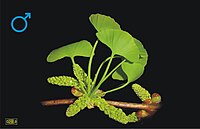
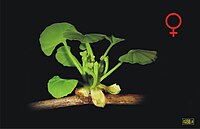
![Extinct Ginkgo yimaensis[48]](https://upload.wikimedia.org/wikipedia/commons/thumb/3/3f/Ginkgo_yimaensis.jpg/120px-Ginkgo_yimaensis.jpg)
![Extinct Ginkgo apodes[48]](https://upload.wikimedia.org/wikipedia/commons/thumb/a/a7/Ginkgo_apodes.jpg/120px-Ginkgo_apodes.jpg)
![Extinct Ginkgo adiantoides, or possibly a new taxon from the US, G. cranei[48]](https://upload.wikimedia.org/wikipedia/commons/thumb/a/a1/Ginkgo_adiantoides_-_G._cranii.jpg/120px-Ginkgo_adiantoides_-_G._cranii.jpg)
![Extant Ginkgo biloba[48]](https://upload.wikimedia.org/wikipedia/commons/thumb/b/b0/Ginkgo_biloba_%28new_form%29.jpg/120px-Ginkgo_biloba_%28new_form%29.jpg)


